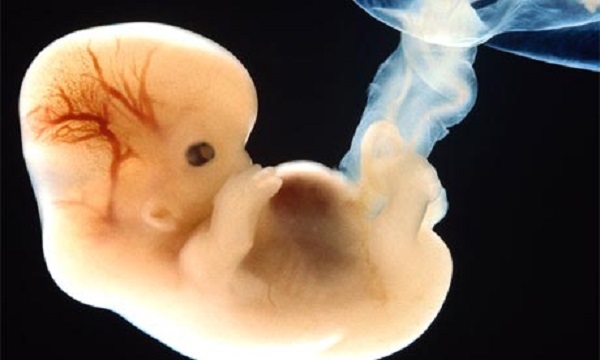The debate over abortion has been raging since at least 1967, when Colorado became the first state to expand legalization of abortion.
And yet, after 50 years and more than 60 million dead babies, this country is still not comfortable talking about abortion. It’s not a topic at the family dinner table. “Well, Susie, what did you do today?” “Oh, I went to Planned Parenthood and got an abortion.” Or “I took my friend to the abortion clinic.” Any woman who is considering abortion knows that someone– a family member, a friend, co-worker, or neighbor–would tell her not to do it.
Why is that? Why do we have that deep-seated discomfort about abortion? Because everyone has that still small voice telling us that we’re talking about the life of a small, innocent human being.
For many years, political leaders who supported abortion would say they were “personally opposed” to abortion, which was code for “but I’m not going to do anything to stop it.” Then Bill Clinton came along and said abortion should be “safe, legal, and rare.” To show you his sincerity as President, he did everything he could to expand the abortion death toll, both in this country and overseas.
But that raised the question– if there is nothing wrong with abortion and it should be legal for anyone who wants one, why should it be rare?
That kind of thinking, that type of reluctance hurts the pro-abortion cause. So groups like Planned Parenthood and NARAL needed to challenge the idea that abortion is bad; they needed to “remove the stigma.” Thus came various campaigns like “Shout Your Abortion,” encouraging women to brag about their abortion, and, of course, the so-called “war on women.” If you think unborn children should be protected, if you think there should be any limits on abortion, you are (supposedly) anti-woman.
Why won’t the abortion industry acknowledge that there are complications and side-effects from abortion; that women have psychological and emotional problems after the abortion; that her risk of breast cancer increases after having an induced abortion?
Why do they not want to recognize the wisdom in bringing parents into the decision-making process when a minor girl is pregnant and considering abortion?
Why are ultrasounds and pregnancy resource centers such a threat to their industry?
Because every time a woman chooses life rather than abortion, every time there are limits placed on abortion, it implicitly or explicitly signals there is something wrong with the procedure.
During the 2016 presidential campaign, it was not until the last debate between Hillary Clinton and Donald Trump that there finally was a discussion about the candidates’ positions on abortion. The moderator pointed out that Clinton had voted to keep partial-birth abortion legal. She defended her position, saying the decision belongs to the woman.
In response, Trump stated, “Well, I think it’s terrible. If you go with what Hillary is saying, in the ninth month, you can take the baby and rip the baby out of the womb of the mother just prior to the birth of the baby. Now, you can say that that’s OK and Hillary can say that that’s OK. But it’s not OK with me, because based on what she’s saying, and based on where she’s going, and where she’s been, you can take the baby and rip the baby out of the womb in the ninth month on the final day. And that’s not acceptable.”
Click here to sign up for pro-life news alerts from LifeNews.com
Clinton supporters went berserk. They were practically screaming, “That doesn’t happen! Abortions don’t happen that late in pregnancy.” They couldn’t deny that Clinton actually does support abortion throughout all nine months because she does. And if they admitted that abortion shouldn’t be legal, even late in pregnancy, their argument fails. If it’s okay and necessary to protect an unborn child at any time (even very late in pregnancy), then abortion is not the simple risk-free expulsion of “fetal matter.”
If there is one tiny crack in that position, if the unborn child is given any credibility, any humanity at all, their position falls apart.
Many know the story about the little Dutch boy who saw a crack in the dike that, if unchecked, could weaken the entire wall and a flood of water would destroy his town. He spent the night in a cold rain, holding his finger in that crack and was hailed the next morning as a hero for saving the town.
In the case of abortion, we want cracks, the more, the better. Think of abortion as the dike and opposition to legal abortion as the water seeking to overwhelm it. Planned Parenthood, NARAL, EMILY’s List, and the entire abortion industry like to think they are the heroes holding their finger in the dike, trying to hold back the flood of pro-life activism that threatens to overwhelm them.
However, according to www.dutchgenealogy.nl, the story is fiction and most Dutch people have never heard it. But as the website says, “…there’s another twist to the story. Not even the Little Dutch Boy could have saved the town. You see, when a dike is about to break, a finger just does not cut it. Dikes don’t typically leak—they weaken until whole sections are washed away. No finger will help when that happens.”
Try as they might to buttress a firm wall of unlimited abortion on demand, the abortion industry will not succeed. Whole sections of that wall are washing away as pro-lifers elect candidates, enact laws, educate fellow citizens, and give pregnant women alternatives to abortion.
The babies will win!
LifeNews Note: Carol Tobias is the president of the National Right to Life Committee.








